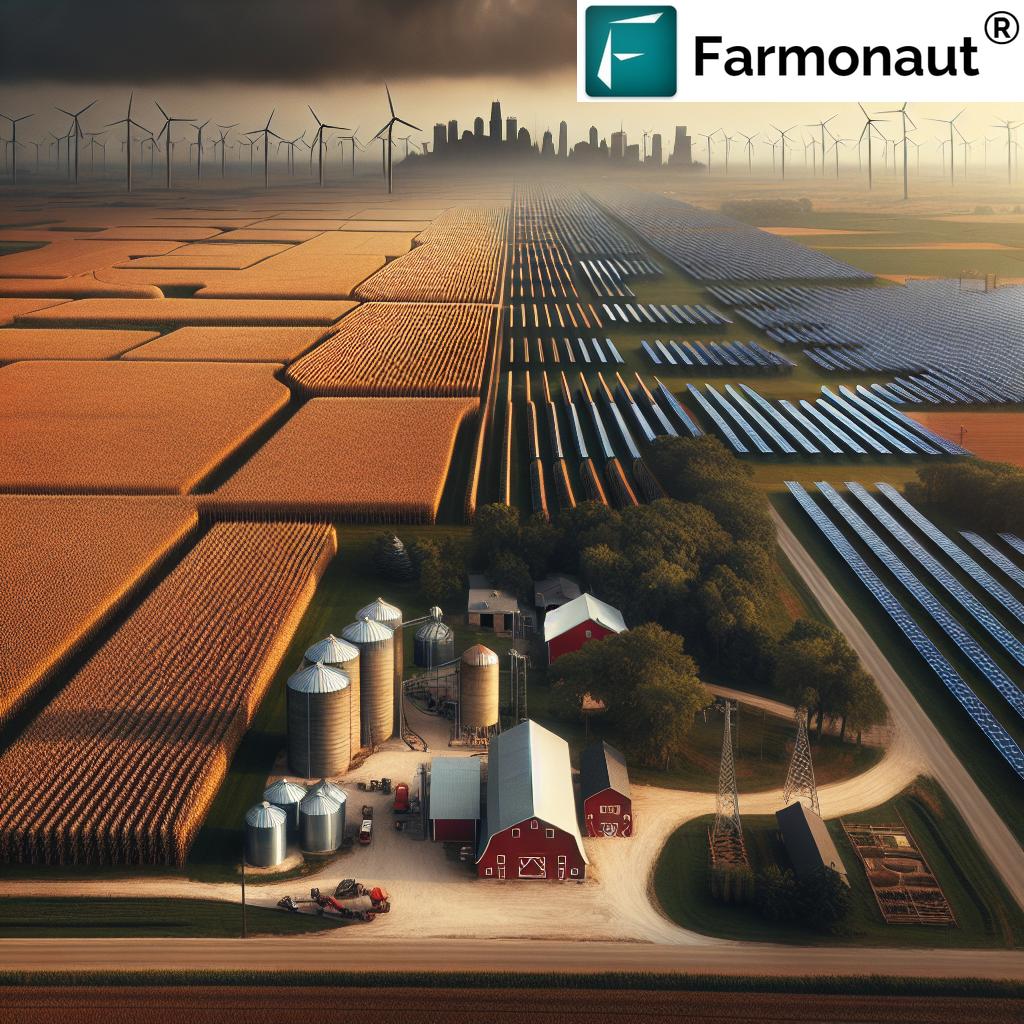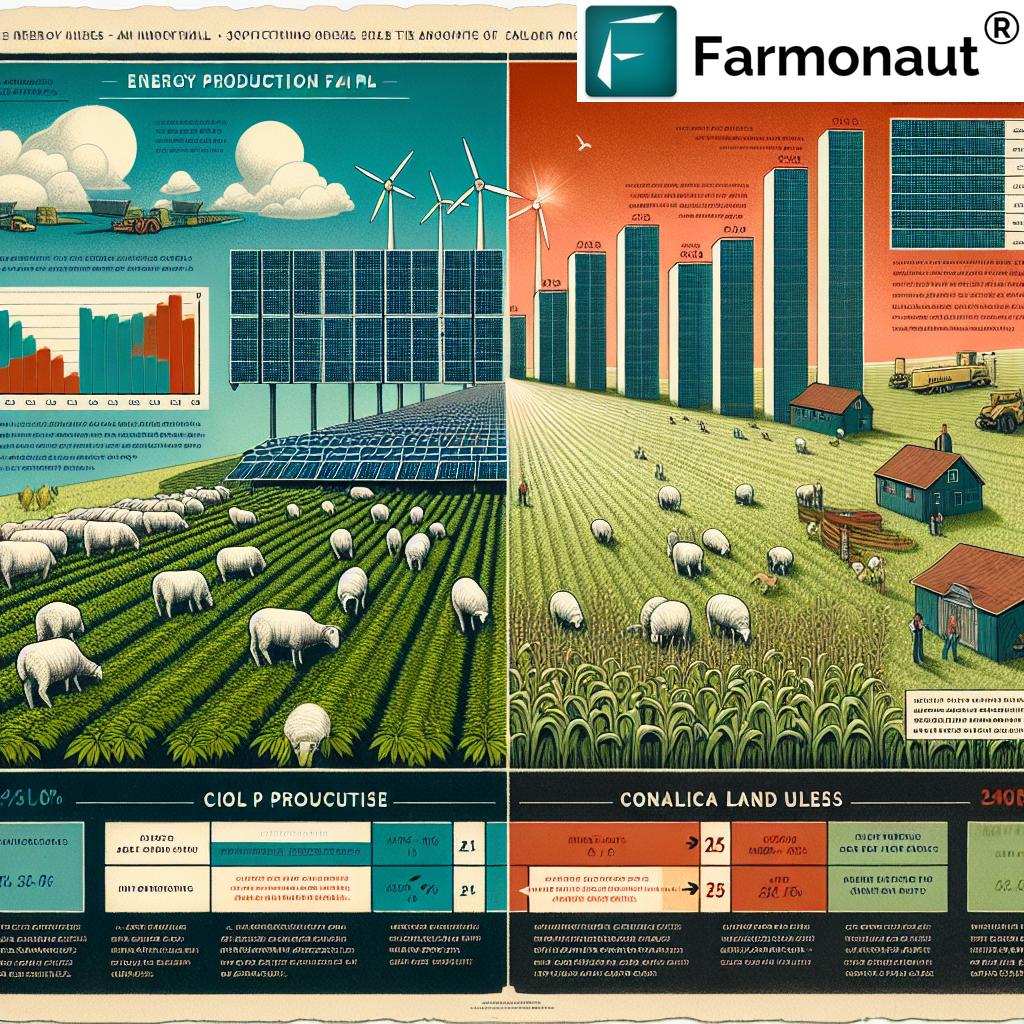Indiana’s Solar Energy Dilemma: Balancing Farmland Preservation and Renewable Power Growth
“Indiana’s solar farm rejections highlight a clash between renewable energy and farmland preservation, affecting thousands of acres.”
As we delve into the complex landscape of Indiana’s renewable energy transition, we find ourselves at the crossroads of progress and tradition. The Hoosier State, known for its vast agricultural heartland, is now grappling with a significant challenge: how to embrace the burgeoning solar energy sector while preserving its cherished farmlands. This dilemma is not just a local issue but a microcosm of the global struggle to balance sustainable energy production with food security and cultural heritage.
The Solar Farm Conundrum in Indiana
Since October 2023, Indiana has witnessed a series of rejections for major solar farm projects across Clark and Jefferson Counties. These projects, collectively designed to generate an impressive 972 megawatts of clean energy, have faced staunch opposition from local communities. The crux of the matter? Nearly 7,000 acres of prime agricultural land that these solar installations would occupy.
To put this into perspective, let’s consider the scale of these proposed projects:
- Total proposed energy generation: 972 megawatts
- Land area required: Approximately 7,000 acres
- Comparative capacity: Less than the nearby Mill Creek Generating Station (1,465 megawatts)
The rejection of these solar projects underscores a growing tension between the push for renewable energy and the preservation of Indiana’s agricultural heritage. During a public meeting about the Idlewild Solar Project, one property owner eloquently expressed the deep-rooted significance of this land, emphasizing its historical role in sustaining local livelihoods.
The Impact on Property Values: Myth or Reality?
“Studies suggest solar farms have minimal impact on property values, potentially offering struggling farmers a new income source.”
One of the primary concerns fueling opposition to solar farms is their potential impact on local property values. To address this, let’s examine the findings of a comprehensive nationwide study:
- Study scope: 1.8 million home sales
- Properties within half-mile of solar farms: Average value decline of 3%
- Monetary impact: Approximately $9,630 loss per transaction
However, it’s crucial to note that these findings aren’t universally applicable. The researchers observed inconsistencies across different states, with some reporting no significant effects on property values. Moreover, the impact diminished considerably for properties located beyond a one-mile radius from the solar projects.
Coexistence of Solar Farms and Agriculture: A Viable Solution?
Despite concerns about land usage, experts in the field suggest that integrating solar farms with agricultural practices could be a harmonious solution. This concept, often referred to as agrivoltaics, presents an intriguing possibility for balancing energy production with food security.
Let’s break down the numbers:
- Projected land requirement for solar capacity by 2050: 4 million hectares
- Current land used for major crops: 90 million hectares
These figures indicate that achieving necessary solar capacity would utilize less than 5% of the land currently dedicated to major crop production. This perspective challenges the notion that solar farms and agriculture are mutually exclusive land uses.
Public policy expert Jerome Dumortier brings another crucial point to the table. He notes that many farmers are struggling financially, with 40-50% of farms reporting unprofitability. In this context, leasing land for solar installations could provide a much-needed alternative income stream for farmers facing economic challenges.
Indiana’s Renewable Energy Potential
Indiana’s landscape, comprising over 80% farmland or forest, holds immense potential for renewable energy expansion. This unique composition presents both opportunities and challenges for the state’s energy future.
Representative Kendell Culp, a farmer himself and a member of the state Energy and Utilities Commission, offers valuable insights:
- Necessity of transitioning to renewable energy
- Potential of nuclear and hydrogen power as alternatives
- Impending energy shortfall in the next five years
Culp’s perspective highlights the urgency of addressing Indiana’s energy needs while considering the state’s agricultural identity.
The Looming Energy Crisis in North America
The energy landscape in North America is facing significant challenges. The North American Electric Reliability Corporation (NERC) has issued a stark warning: over half of the continent faces elevated risks of energy shortages in the next 5 to 10 years. This prediction underscores the critical nature of Indiana’s energy decisions.
Key factors contributing to this energy crisis include:
- Surging demand from electric policies
- Rapidly escalating energy requirements of data centers
- Projected energy growth jump from 6% in 2022 to 17% for 2024

Reliability Concerns: Solar vs. Fossil Fuels
As we integrate more renewable energy sources like wind and solar farms into our energy mix, questions about reliability persist. Unlike fossil fuels, solar energy production is dependent on weather conditions, raising concerns about consistent power supply.
NERC’s response to this challenge is clear: ensure a managed transition pace to avoid reliability issues. This recommendation highlights the need for a balanced approach to energy transition, one that doesn’t compromise the stability of our power grid.
The Climate Change Imperative
Amidst these discussions, we must not lose sight of the bigger picture: the urgent need to address climate change. Dumortier eloquently articulates this point, reminding us of the long-standing knowledge about the environmental impact of coal usage and the pressing need to transition toward renewable energy sources.
While there may be short-term costs associated with this transition, the long-term benefits of managing the climate crisis are undeniable. As we weigh the pros and cons of solar farm installations, we must consider not just the immediate impact on land use and property values, but also the broader environmental implications of our energy choices.
The Role of Technology in Sustainable Agriculture
As we navigate these complex issues, it’s worth considering how technology can play a role in optimizing both energy production and agricultural practices. Farmonaut, a pioneering agricultural technology company, offers innovative solutions that could contribute to this balancing act.
Farmonaut’s satellite-based farm management solutions provide farmers with valuable tools for precision agriculture, including:
- Real-time crop health monitoring
- AI-based advisory systems
- Resource management tools
By leveraging these technologies, farmers can optimize their land use, potentially freeing up areas for solar energy production while maintaining or even improving agricultural yields.
Comparative Analysis: Solar Farms vs. Traditional Agriculture
To better understand the trade-offs between solar farm installation and traditional farming in Indiana, let’s examine a comparison of key aspects:
| Aspect | Large-Scale Solar Farm | Traditional Corn/Soybean Rotation | Mixed Use (Solar + Agriculture) |
|---|---|---|---|
| Land Use (acres) | 2,000 | 2,000 | 2,000 |
| Annual Energy Production (MWh) | 400,000 | N/A | 200,000 |
| Job Creation (estimated jobs) | 50 | 10 | 40 |
| Environmental Impact (CO2 reduction tons/year) | 280,000 | -5,000 | 135,000 |
| Economic Impact (estimated annual revenue) | $20 million | $1.5 million | $15 million |
This comparison illustrates the potential benefits and trade-offs of different land use options. While large-scale solar farms offer significant energy production and environmental benefits, they may have a lower direct job creation impact compared to traditional farming. The mixed-use approach presents an interesting middle ground, potentially offering both energy production and agricultural benefits.
Community Perspectives and Concerns
As communities in Kentuckiana grapple with the balance between agricultural heritage and the push for renewable energy, local voices play a crucial role in shaping the debate. Some of the key concerns expressed by residents include:
- Loss of prime agricultural land
- Potential impact on rural aesthetics
- Questions about long-term land restoration after solar farm decommissioning
- Concerns about food security and local agricultural economy
These perspectives highlight the need for comprehensive community engagement and transparent decision-making processes as Indiana charts its energy future.

The Role of Policy and Regulation
As Indiana navigates this complex landscape, the role of policy and regulation becomes increasingly important. State and local governments face the challenge of crafting policies that encourage renewable energy development while protecting agricultural interests. Some potential policy approaches include:
- Implementing smart zoning regulations that designate appropriate areas for solar development
- Creating incentives for dual-use solar projects that combine energy production with agriculture
- Developing guidelines for the responsible decommissioning and land restoration of solar farms
- Establishing community benefit agreements to ensure local residents share in the economic advantages of solar projects
These policy considerations could help strike a balance between renewable energy goals and farmland preservation.
The Future of Energy in Indiana
As we look to the future, it’s clear that Indiana’s energy landscape is poised for significant transformation. The state’s abundant farmland and growing energy needs present both challenges and opportunities. By embracing innovative technologies and balanced policies, Indiana has the potential to become a leader in sustainable energy production while preserving its agricultural heritage.
Some potential scenarios for Indiana’s energy future include:
- Increased adoption of agrivoltaics, combining solar energy production with crop cultivation
- Development of community solar projects that allow multiple residents to benefit from a single installation
- Integration of energy storage solutions to address the intermittency of solar power
- Expansion of other renewable energy sources, such as wind and biomass, to complement solar installations
These approaches could help Indiana meet its growing energy demands while minimizing the impact on valuable farmland.
The Role of Agricultural Technology
As we consider the future of energy and agriculture in Indiana, it’s worth exploring how advanced agricultural technologies can contribute to this balancing act. Farmonaut’s innovative solutions offer a glimpse into how precision agriculture can optimize land use and potentially create synergies with solar energy production.
For instance, Farmonaut’s satellite-based crop health monitoring system allows farmers to:
- Identify underperforming areas of their fields that might be suitable for solar installations
- Optimize resource use on productive land, potentially freeing up space for energy production
- Monitor the impact of nearby solar installations on crop health and yields
By leveraging these technologies, farmers can make data-driven decisions about land use, potentially finding ways to integrate solar energy production without significantly impacting overall agricultural output.
Economic Implications for Indiana’s Farmers
The potential economic impact of solar energy on Indiana’s agricultural sector is a crucial consideration. While concerns about farmland loss are valid, it’s important to consider the potential financial benefits for farmers who choose to lease their land for solar projects. Some key points to consider include:
- Stable, long-term income from solar leases, which can help offset fluctuations in crop prices
- Potential for increased property values due to guaranteed income streams
- Opportunities for farmers to diversify their income sources
- Possible tax incentives for participating in renewable energy projects
These economic factors could provide much-needed financial stability for Indiana’s farming communities, especially in areas where agricultural profitability has been declining.
Environmental Considerations
Beyond the immediate concerns of land use and energy production, it’s crucial to consider the broader environmental implications of Indiana’s energy choices. Solar energy offers significant environmental benefits that should be weighed against the potential loss of agricultural land:
- Reduction in greenhouse gas emissions compared to fossil fuel-based energy production
- Potential for improved soil health in areas where solar installations replace intensive farming practices
- Opportunities for habitat creation and biodiversity enhancement around solar farms
- Reduced water usage compared to traditional power plants
These environmental factors underscore the importance of taking a holistic approach to land use decisions, considering both short-term impacts and long-term sustainability goals.
Innovative Approaches to Solar Farm Design
As technology advances, new approaches to solar farm design could help address some of the concerns raised by Indiana’s communities. Some innovative concepts include:
- Vertical solar panels that allow for continued agricultural use of the land beneath them
- Floating solar farms on reservoirs or unused water bodies, preserving valuable farmland
- Solar greenhouses that combine energy production with protected crop cultivation
- Mobile solar arrays that can be temporarily installed on fallow fields
These creative solutions demonstrate that with ongoing innovation, it may be possible to find ways to integrate solar energy production more seamlessly into Indiana’s agricultural landscape.
The Path Forward: Collaboration and Compromise
As Indiana grapples with this complex issue, it’s clear that finding a solution will require collaboration and compromise from all stakeholders. Some key steps that could help move the conversation forward include:
- Establishing multi-stakeholder committees to develop balanced land use policies
- Conducting comprehensive impact assessments that consider both agricultural and energy needs
- Investing in research and development of dual-use technologies
- Creating educational programs to help farmers and communities understand the potential benefits and challenges of solar energy integration
By fostering open dialogue and seeking innovative solutions, Indiana has the opportunity to become a model for sustainable energy development that respects agricultural heritage and meets the needs of a changing world.
Conclusion
Indiana’s solar energy dilemma encapsulates the broader challenges faced by many regions as they navigate the transition to renewable energy. The tension between preserving valuable farmland and meeting growing energy demands is not easily resolved, but it presents an opportunity for innovation and thoughtful policy-making.
As we’ve explored, there are valid concerns on both sides of the debate. The potential loss of agricultural land and its impact on rural communities must be carefully weighed against the urgent need for clean energy sources and the economic opportunities they present. However, emerging technologies and innovative approaches suggest that it may be possible to find a middle ground that serves both agricultural and energy needs.
The path forward for Indiana will likely involve a combination of smart policies, technological innovation, and community engagement. By embracing solutions like agrivoltaics, leveraging precision agriculture technologies, and exploring creative solar farm designs, the state can work towards a future where renewable energy and agriculture coexist and thrive.
Ultimately, addressing Indiana’s solar energy dilemma will require a collaborative effort from farmers, policymakers, energy companies, and local communities. By working together and remaining open to new ideas, Indiana has the potential to become a leader in sustainable land use and renewable energy development, setting an example for other states facing similar challenges.
As we move forward, it’s crucial to keep the bigger picture in mind. The transition to renewable energy is not just about meeting immediate energy needs or preserving current land use patterns. It’s about creating a sustainable future for generations to come. By carefully balancing the preservation of farmland with the growth of renewable power, Indiana can play a vital role in addressing climate change while maintaining its rich agricultural heritage.
The decisions made today will shape Indiana’s landscape, economy, and environmental impact for decades to come. By approaching this challenge with creativity, compassion, and a commitment to sustainability, Indiana can turn its solar energy dilemma into an opportunity for growth, innovation, and environmental stewardship.
FAQ Section
Q: How much land is typically required for a large-scale solar farm in Indiana?
A: Large-scale solar farms in Indiana can vary in size, but they typically require several hundred to a few thousand acres. The recent rejected projects were planning to use nearly 7,000 acres collectively.
Q: What is the average impact of solar farms on nearby property values?
A: According to the nationwide study mentioned, properties within a half-mile of solar farms saw an average value decline of 3%, or about $9,630 per transaction. However, this impact varies by location and diminishes beyond a one-mile radius.
Q: Can agricultural activities continue on land used for solar farms?
A: Yes, in many cases. This concept, known as agrivoltaics, allows for dual use of land for both solar energy production and certain types of agriculture, such as grazing or shade-tolerant crop cultivation.
Q: How does the energy output of solar farms compare to traditional power plants?
A: While solar farms can generate significant amounts of clean energy, their output is generally less than large fossil fuel plants. For example, the rejected solar projects would have generated 972 megawatts, compared to the 1,465 megawatts capacity of the nearby Mill Creek Generating Station.
Q: What are the potential economic benefits for farmers who lease their land for solar projects?
A: Farmers can benefit from stable, long-term income through solar leases, which can help offset fluctuations in crop prices and provide financial stability, especially for struggling farms.
Q: How might climate change impact the decision-making process regarding solar farms in Indiana?
A: Climate change considerations add urgency to the transition towards renewable energy sources like solar. While there may be short-term costs, experts argue that addressing climate change through renewable energy adoption will yield long-term environmental and economic benefits.
Q: Are there any innovative solutions being explored to balance solar energy production with farmland preservation?
A: Yes, several innovative approaches are being explored, including vertical solar panels, floating solar farms, solar greenhouses, and mobile solar arrays. These solutions aim to integrate solar energy production more seamlessly with agricultural practices.
Q: How can communities voice their concerns about proposed solar farm projects?
A: Communities can participate in public meetings, engage with local planning committees, and provide input during the zoning application process. Many counties have specific procedures for public comment on large-scale development projects.
Q: What role does state policy play in the development of solar farms in Indiana?
A: State policies can significantly influence solar farm development through zoning regulations, incentives for renewable energy projects, and guidelines for land use. The state government plays a crucial role in balancing energy needs with land conservation priorities.
Q: How might advanced agricultural technologies like those offered by Farmonaut contribute to this issue?
A: Technologies like Farmonaut’s satellite-based crop monitoring can help farmers optimize their land use, potentially identifying areas suitable for solar installations while maximizing productivity on remaining farmland. This could contribute to finding a balance between energy production and agriculture.
Earn With Farmonaut: Earn 20% recurring commission with Farmonaut’s affiliate program by sharing your promo code and helping farmers save 10%. Onboard 10 Elite farmers monthly to earn a minimum of $148,000 annually—start now and grow your income!






